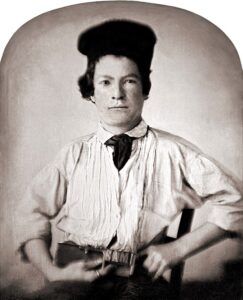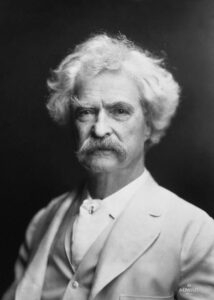Road Trip Through History: In Search of Mark Twain in Hannibal MO
- Samuel Clemens, 1850
- Mark Twain 1907
Unlike most of the places we’ve visited on our expeditions along the Great River Road, I had been to Hannibal, Missouri, before. But it had been a long time—decades in fact. When we drove into town on this trip, I carried two sharp memories—a recreation of the famous scene in which Tom Sawyer tricks other boys in whitewashing the fence and the thrill of seeing Mark Twain’s typewriter*—and a vague recollection of heat, dust, and shabbiness.
Although the town itself still is a bit shabby, the official Mark Twain interpretive center is not. The center uses a cluster of buildings related to Twain’s boyhood—or more accurately, to Samuel Clemens’ boyhood**—to tell the story of the man who became Mark Twain. (The museum’s emphasis on his boyhood is entirely appropriate. Clemens left Hannibal twenty years before he wrote Tom Sawyer.)
The museum uses names and imagery from Tom Sawyer to orient the visitor***—the Becky Thatcher house, for example—but the exhibits draw a clear distinction between Twain and his fictional alter-ego. While the exhibits are family-friendly, they take a close look at hard subjects, both within Twain’s life (his father’s death, his family’s fluctuating financial position, his apprenticeship as a printer’s assistant at the age of twelve) and in society as a whole (slavery, class differences, mortality rates). I was particularly taken with the exhibits in the “Huckleberry Finn” house, which looked at the life of the boy on whom Twain based the character, comparing the poverty in which he was raised with Twain’s romanticism about the boy’s freedom in Tom Sawyer. The exhibit did an excellent job of examining how Twain wove real-life details into the novel—always fascinating to a writer.
The only thing I was disappointed by was the way the interpretive center dealt with Mark Twain’s life after he became Mark Twain. His later life was complicated and in many ways unhappy. Instead of looking at that with the same clear-eyed focus they gave to his boyhood, they used the books as a chronology, with very little information about the man. And while the books are the important thing when looking at any writer, I was not taken by the combination of life-sized dioramas, long quotations, and brief synopses that they used to discuss the books. On the other hand, they show a 90-minute video on Huckleberry Finn and its importance in American literature in an earlier part of the museum that was fabulous.
On the whole, well worth a visit.
*The only historical fact that I held on to from that visit was the fact that Twain was an early adopter of the typewriter. Neither that fact nor the typewriter itself were part of current Twain exhibits.
**I’ve chosen to refer to him as Twain for the rest of this post instead of flipping back and forth.
***As does Hannibal as a whole.
Travelers’ Tips
- If possible, organize your visit to include Mark Twain Himself, a one-man show in the Planters’ Barn Theater. We stayed in town an extra night so we could see it and were very happy we did.
- We missed a smaller museum that looks like it would have been well worth seeing: Jim’s Journey: The Huck Finn Freedom Center. The museum uses Dan Quarles, the real-life prototype for the character Jim in Huckleberry Finn, as a lens for looking at the African-American experience in Hannibal and the surrounding region. We may need to pass through Hannibal again.







On my tablet, I have many books that have peeked my interesm. Chasing the Last Laugh Mark Twain’s Raucous and Redemptive Round- the-World Comedy Tour. by Richard Zacks is one. 2016, doubleday. (here I paraphrase) Starting in 1896, embarking on his trip to circle the world with his wife and daughter, to entertain English speaking audiences and to make a lot of money to pay off his debts and bad investments. International celebrities do get perks.Some almost too amazing to be true. It becomes a Travel Guide and telling stories along the way is what he was good at doing. The highest-paid writer in America had succeeded in losing his entire fortune and that of his wife’s inheritance in bad investments and encouraged others to follow him. Thinking himself shrewd and savvy. His wife Livy felt the shame more deeply. Believing that failing in business means disgrace. Samuel L. Clemens, a hodgepodge of uplifting sentiment and bad habits, flash mood swings and temper tantrums to jokes who raced to judgement and often rued it. His year long trek had him perform 122 nights in 71 cities and spend 98 nights at sea, 50 days ill. Traveling by rail, rickshaw, mule carriage, man-toted palanquin and elephant, As he put it, raiding and pillaging and planning to talk his way out of hell and humiliation. There are lots of quotations in this book that will give the reader a feel and an insight into the man called Mr. Mark Twain..for me.
Another good Twain book: “How Not to Get Rich: The Financial Misadventures of Mark Twain” by Alan Pell Crawford.